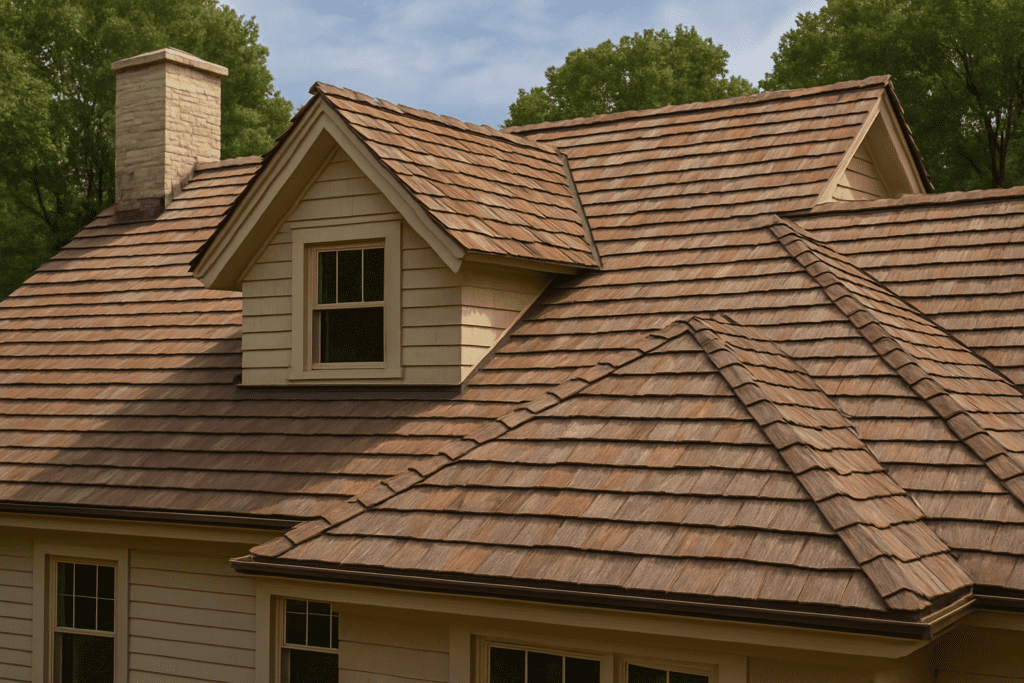There’s something unmistakably honest about cedar. Maybe it’s the way the grain catches afternoon light, or how it softens into silvery gray after years of sun, rain, and snow. For homeowners who want a roof that does more than keep out the weather—a roof that tells its own story over time—cedar shake has long stood apart.
Cedar shake roofing is more than just a stylistic nod to tradition. It’s durable, eco-conscious, and remarkably effective in a wide range of climates. Whether topping off a lakeside cottage or lending character to a modern home, its natural warmth and resilience make it a choice worth considering.
The Natural Advantage
Cedar grows with defense mechanisms baked right in. The wood itself contains oils and tannins that naturally resist moisture, insects, and decay. That’s one of the reasons cedar shake has remained a favorite in regions with variable seasons—it doesn’t just look rugged, it is.
Properly installed and maintained, cedar shake roofs routinely last 30 to 40 years. That’s not just marketing. It’s backed by decades of installations that are still holding strong. Even in areas with harsh winters or summer heat, cedar adapts well with proper airflow and structure.
How It Holds Up Over Time
Unlike manufactured shingles that fade and crack, cedar ages like wood should—gradually and with grace. When first installed, shakes carry a warm reddish tone. As years go by, that tone mellows into a soft gray, a transformation many homeowners come to love.
The thickness and natural variability of each shake give cedar roofs a texture and depth that’s difficult to imitate. It doesn’t sit flat like asphalt; it rises and dips ever so slightly, catching light and casting small shadows that change with the hour.
Built-In Insulation and Ventilation
Another often-overlooked benefit of cedar? It breathes. Literally. Cedar allows just enough airflow to support attic ventilation, which helps prevent trapped moisture and excessive heat buildup. In winter, that can reduce ice damming. In summer, it helps cut down on cooling costs.
Cedar also insulates well. It creates a natural thermal barrier between your interior space and the elements, contributing to more stable indoor temperatures throughout the year.
Sustainability, From Forest to Roofline
For homeowners thinking beyond aesthetics, cedar scores high on environmental impact. It’s a renewable resource—harvested from managed forests—and requires significantly less energy to produce than composite or metal options. When a cedar roof eventually needs to be replaced, the material can be recycled or allowed to biodegrade naturally.
In addition, many shakes used today come from responsibly harvested forests, where replanting and forest management ensure sustainability for the future.
Fire Ratings and Modern Treatments
If fire risk is a concern—and in some regions, it should be—fire-retardant treated cedar shakes are widely available. These meet Class B or even Class A ratings when used with appropriate underlayment systems, satisfying local codes and insurance standards in most areas.
Modern pressure treatments have come a long way. Today’s treated cedar shakes retain their natural appearance while improving resistance to fire, UV damage, and fungal growth. This adds another layer of longevity to a roofing system already built to last.
Maintenance That Pays Off
Yes, cedar shake does require upkeep. But not in the way people often assume. Biannual inspections, removal of debris, and gentle cleaning in shaded areas are typically enough. Moss and algae can be managed with occasional treatment. If a few shakes curl or split over time, they can be replaced individually—no need to tear off whole sections.
Compare that to the full re-roofing required when asphalt shingles hit their limit, and the long-term costs of cedar start to look more appealing.
Why Experience Matters
Installation plays a critical role in the lifespan of any cedar roof. Proper spacing for airflow, high-quality fasteners, and careful flashing around chimneys and valleys all contribute to performance. Ventilation is particularly crucial—without it, even the best materials can falter over time.
That’s why working with experienced professionals is non-negotiable. A skilled contractor understands not only the materials but also the nuances of your region’s climate, code requirements, and architectural details.
Cedar Shake Roofing for Homes That Age Gracefully
Choosing cedar shake roofing isn’t just about curb appeal—it’s about committing to craftsmanship, character, and a roof that feels like it belongs to the home, not just on top of it. For those who appreciate quality that deepens over time, it’s hard to imagine a better fit.
If you’re considering a roofing material that blends strength, style, and sustainability, it may be time to take a closer look at cedar shake. The beauty’s obvious—but the value runs much deeper.

